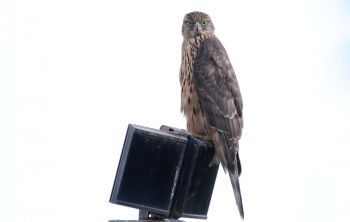- Accipiter gentilis
Identification
46–63 cm (18-25¾ in) Large, robust accipiter.
- head proportionately small but neck long
- tail long, narrow with rounded tip
- Wings quite short and rounded
- supercilium bold, white
Adult
- above blue-grey (intensity varies: may appear lead-grey)
- crown and ear coverts blackish
- underparts pale, finely barred with grey
Immature Brown above and streaked below
Similar species
Female Eurasian Sparrowhawk (which see).
Distribution
A widespread species in the Western Palearctic breeding from northern Africa and Iberia east to the Black Sea and Caucasus and north to the UK, northern Scandinavia and Arctic Russia; also found further east in Asia to China, Mongolia, South Korea and Japan.
Taxonomy
Formerly considered the same species as American Goshawk under the name of Northern Goshawk.
Subspecies
Clements recognises the following subspecies [1]:
- A. g. gentilis: Europe (except for the northeast and southeast) and northern Morocco
- A. g. buteoides: Northern Eurasia (Sweden to Lena River); winters to central Asia
- A. g. albidus: North-eastern Siberia to Kamchatka Peninsula
- A. g. schvedowi: North-eastern Asia to central China; winters to northern Indochina
- A. g. fujiyamae: Japan
- A. g. arrigonii: Corsica and Sardinia
- A. g. marginatus: Italy and the Balkans east to the Caucasus and northern Iran
Habitat
Deciduous or coniferous woodland interspersed with open areas. Often over more open country in winter.
Behaviour
Action
They often sit upright, with a hip-heavy outline. They fly at tree-top level with slow wing-beats interspersed with short straight glides.
Diet
Their diet consists mostly of small and medium sized birds and mammals, even capercaillie and hares.
Breeding
They nest high in a tree, about 10-15 m up. They often re-use the nest.
Vocalisation
Usually silent, sometimes lets out a loud kak-kak-kak-kak-kak when disturbed.
References
- Clements, J. F., P. C. Rasmussen, T. S. Schulenberg, M. J. Iliff, T. A. Fredericks, J. A. Gerbracht, D. Lepage, A. Spencer, S. M. Billerman, B. L. Sullivan, and C. L. Wood. 2023. The eBird/Clements checklist of Birds of the World: v2023. Downloaded from https://www.birds.cornell.edu/clementschecklist/download/
- Gill, F, D Donsker, and P Rasmussen (Eds). 2023. IOC World Bird List (v 13.2). Doi 10.14344/IOC.ML.13.2. http://www.worldbirdnames.org/
- Avibase
- Handbook of the Birds of the World Alive (retrieved March 2017)
- Collins Bird Guide ISBN 0 00 219728 6
Recommended Citation
- BirdForum Opus contributors. (2024) Eurasian Goshawk. In: BirdForum, the forum for wild birds and birding. Retrieved 26 December 2024 from https://www.birdforum.net/opus/Eurasian_Goshawk
External Links
GSearch checked for 2020 platform.1








